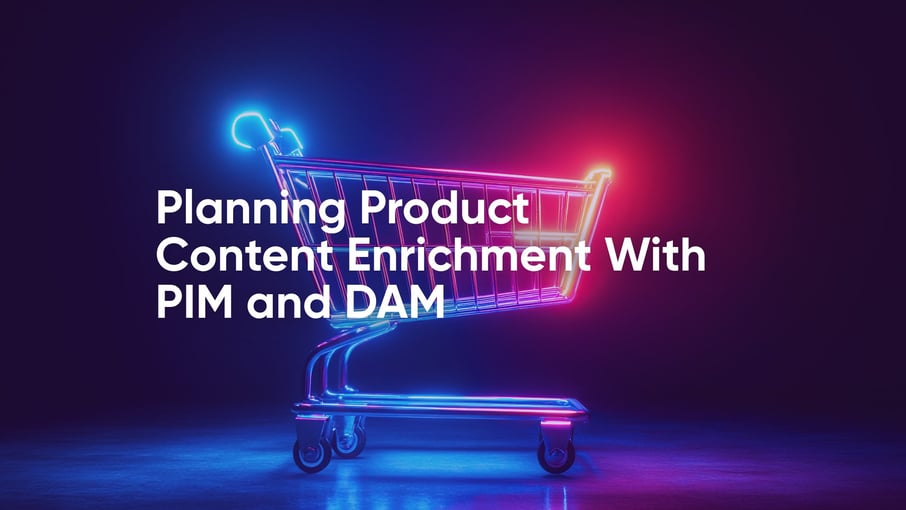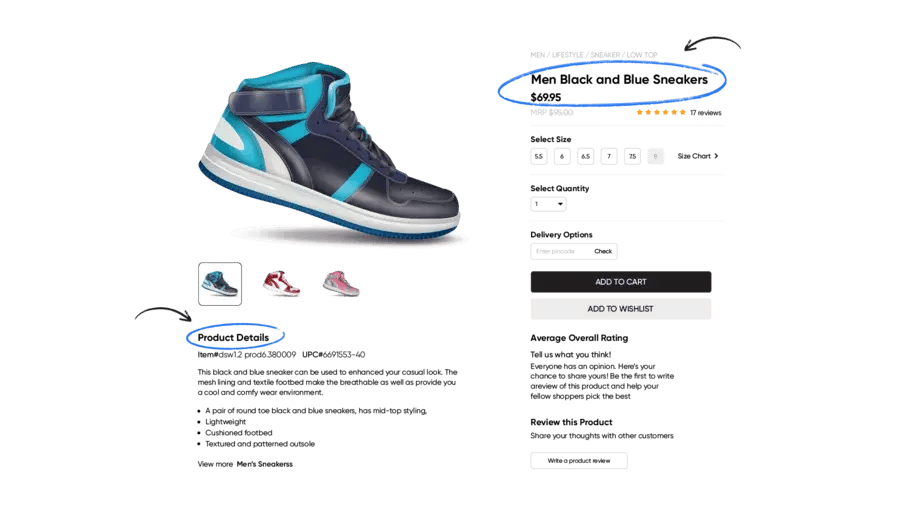
It has now gone beyond ‘giving customers what they want, exactly when they want, and how they want.’ Digital commerce’s sophistication level has risen unprecedently. The need to simplify the complexity and amplify product content quality—that addresses the requirements and surprises and delights customers at every step of their engagement—is now vital. And at a time when business leaders are relying heavily on data and analytics, the role of enriched product content becomes even more critical. To bring outstanding customer experiences to life, customers must see value in products, especially considering their vast number of choices. That’s where product information management (PIM) comes in; it helps realize product content’s potential completely.

What Is Product Content Enrichment?
Product content enrichment refers to the entire process, from ingestion, cleansing, and standardization, to improving product data and information and turning it into accurate, fully machine-readable content while imparting customer-centric attributes to it. Specifically, digital commerce’s product content enrichment comprises text specifications, technical details (if applicable), images and rich media content, and any relevant data about the product. In other words, product content enrichment aims to increase customer engagement and enhance shopping experiences by creating searchable product content by including rich product attributes.
How Product Content Enrichment Takes Place?
Product content enrichment takes place with the help of product taxonomies that comprehends the associations among a product’s contents, thereby aiding customer experience and searchability. Robust taxonomies speed-up content enrichment process by easily recognizing and distinguishing the associations and concepts for a vast range of product categories. Today’s product content enrichment software considers how people naturally look and shop for products, minimizing inaccurate categorizations. Thus, with the help of enriched content, the discoverability of products and their navigation happens in the natural language of customers. In addition, there are various formats in which product data can appear such as SKUs from ERPs, product information from PIM and Digital Asset Management (DAM), pdfs, spreadsheets, social media content, and customer review sites.
Key Benefits of Product Content Enrichment
| Keeps Content Valuable but Captivating | Demand, Consumption, and Forecasting | Optimizing Supply Chain |
| Once all the information is consolidated and assimilated from various systems, enriched content is presented in a language that customers speak, making shopping a delightful journey. In addition, with all attributes correctly mapped, content is better organized and complete. Moreover, if guides such as manuals, brochures, user reviews, and links to additional resources are included, it nurtures the connection between the customer and the brand further. | When product attributes are structured correctly, on-site conversions take place effectively. It facilitates better shopping experiences and impacts customer choice. It also helps marketing teams drive sales, comprehend merchandise consumption patterns, and forecast future demand. Improving demand is a critical need fulfilled by highly fine-tuned product data. Hence, most profitable products and SKUs can be identified and positioned better to make product catalogs look more attractive. | Streamlining product content and building improved taxonomies can help in optimizing the supply chain. Instead of pre-ordered inventories, retailers can go for leaner, demand-driven product ordering, optimizing logistics and supplier-related expenses. It brings control in the supply chain markup costs. This, in turn, clears the way for offering customers more favorable discounts and deals. On the other hand, it empowers product teams to concentrate more on creating better strategies. |
Empowering eCommerce Through Enriched Product Content
Online stores and marketplaces need high-end product pages (containing product descriptions, specifications, images, videos, rich media, reviews and ratings, comparison charts, FAQs, and mapping information with related products) to turn visitors into shoppers. Software such as PIM aids the creation of catalogs and helps in their management. Updating product content becomes a flexible and convenient with the right functionalities to create, edit, and enrich product pages. A primary requirement for high-quality eCommerce pages is to ensure fewer errors and discrepancies and make the products relevant and searchable for customers. Inline editing for bulk imports from spreadsheets and personalization of drag-and-drop columns remain crucial features, along with better flexibility to update product features in bulk via a mass updating function. Enriched products must also comply with eCommerce filtering to show correct results. Most eCommerce platforms need relationships built among various product categories and segments to enable up-selling and cross-selling to expedite promotion and product bundling.
Creating Shoppable Content with PIM and DAM
PIM and DAM help businesses consolidate, streamline, enrich, and disseminate product and digital media assets (including images, videos, documentation, graphics, and animations) to various channels. Most modern-day PIMs can manage millions of SKUs having thousands of attributes effortlessly. PIM facilitates product enrichment by placing enhanced, optimized, consistent product information on every sales channel, thereby imparting the content with advanced omnichannel capabilities. It streamlines content according to its geographical suitability, thereby improving product searchability via search engines. PIM helps marketing and product teams create superior strategies to optimize real-time customer experiences and engagement. By creating a repository of high-quality product data, PIM helps in improving the performance of business for all stakeholders both inside as well as outside the organization, such as:
- Merchandisers: Enables merchandisers to place product data contextually with other products and fulfill customer demand.
- Marketing Teams: They can arm themselves with high-end product content to drive demand and create high-quality product experiences.
- Retailers: For businesses to have proper control on how their product data is displayed across retail channels, PIM ensures accurate market syndication.
- E-commerce teams: E-commerce teams are supplied with the assets they need to ensure online selling takes place seamlessly.
- Operations and Management: Both operations and management teams can rely on correct product information so critical and costly errors are averted.
Steps for Product Content Enrichment
| a) Plan | b) Develop and Prioritize | c) Amplify |
| Content planning must not begin and end with customers in mind. Understanding who they are, where they are coming from, and where they are in their buying journey are the starting points for content planning. Content must offer enough opportunity to the targeted buyer personas to explore, evaluate, or engage with products. It must be planned so that it answers customer questions through accurate and complete content descriptions, digital assets, brochures, and manuals, which can lead customers to explore more transparently as transparency builds trust. Looking at products comprehensively offers customers the confidence to choose. Enrichment must be planned to create connections and empower customers. | Once developed accurately and precisely, content needs to be constantly reviewed, audited, and tracked, down to the last sales channels. Content gap identification and fixing should not be a one-off but an ongoing process. Product owners and marketers must constantly analyze the needs of the customer, figure out the missing parts and deliver content that adds value for a successful buying journey—also, the freshness of content matters. If there have been any changes or advancements in a product, a new industry regulation has come in and has been implemented, then it must reflect in the product content. Other aspects must be assessed, such as content localization and where it fits in the buyers’ journey. | As product data is assimilated, quality-checked, verified, and standardized, it must be validated for channel readiness and contextualization to amplify the effect. The aim is to maximize ROI by launching up-to-the-minute information quickly across various sales channels. Carefully designed, consistent, product-centric content must be pushed across channels to support early buyer journey, middle-of-the-journey, and decision-making content (such as case studies and testimonials). The choice to amplify content also involves assessing what to keep, modify, and retire in the product data and which assets must be extended to new personas and activity streams. |
PIM and DAM: The Ultimate Allies for a Range of Product Content Needs
Enriched, flawless product content is the foundation for impeccable product stories. However, over time, having many users working on the data may result in cropping up of inconsistencies. Product content enrichment is critical for searches and transactions and genuinely getting closer to your customers and fulfilling their needs. Consistency and completeness of content also aid customers in streamlining and refining product searches.
PIM and DAM allow the standardization of data attributes for SKUs and remove redundancies. They have the capability to manage millions of SKUs and a vast number of attributes for all kinds of data management needs—right from simple selling (no upsell/cross-sell needed) to mildly complex selling (having select single product combinations) to highly complex selling (offer based product packages). They can integrate product content from many sources (ERPs, suppliers, content agencies, PLMs, etc.) and distribute it to any number of channels or customer touchpoints in multiple locations.
Pimcore Use Case
Pimcore helped a multinational retail franchise operator streamline their product content to achieve better transparency, time-to-market, and reduce processing cost.
The organization’s product and marketing content, digital asset, and pricing data ingestion happened via custom scripts, a poorly managed process.
Data was in fixed formats, live processing did not exist, and legacy processes limited the system configuration. It resulted in prolonged data management time. Business users could not analyze data; errors were frequent. Hence product content quality suffered highly.
Pimcore implemented PIM and DAM to manage product content for the organization’s seven brands comprising approximately 1.5 to 1.8 million products. It enabled dynamic configuration and data validation to remove redundancies and streamline data processing while eliminating manual effort. Real-time visibility of processes was enabled through automatically downloadable logs—batch processing and tracking enhanced transparency further. Live tracking was implemented to include audit reports, change logs, and data trends. A graphical view of reports and pictorial representation were introduced.
As a result, the time to ingest content is reduced drastically. Data publishing time slowed, and operational efficiency and ease of use improved. Data quality improved significantly; manual intervention was eliminated. The most significant gains were that high-quality, enriched, automated product content improved time-to-market. Due to automation, the dependency on technical teams was reduced. Data tracking was entirely transformed, considerably improving efficiency. Live, granular data reporting enhanced accuracy, which boosted overall performance.
